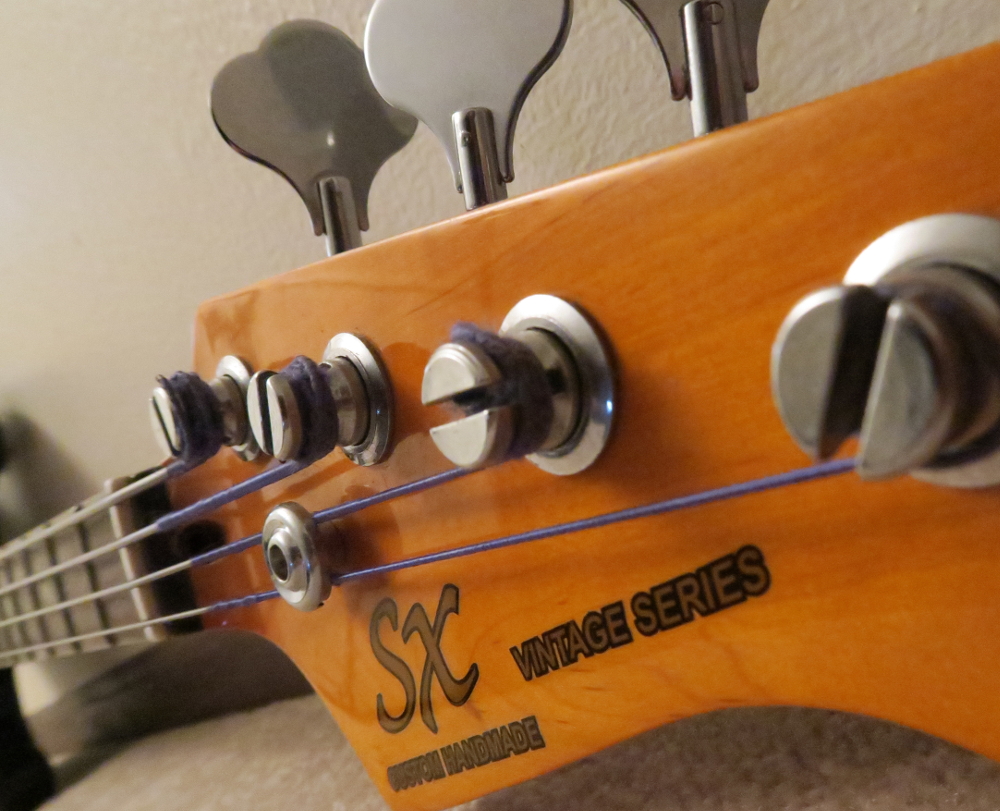
Guitar string order is easy to learn and I want to provide you that information. When you are done reading, you will be able to answer, “what are the guitar strings?”
Your stringed instrument has tuning pegs on it. These pegs will determine how many strings your guitar should have.
Although you may have any number of pegs (therefore, strings, as well) I am only going to focus on the order or a 6-string guitar. That is the most popular for electric and acoustic instruments.
Strings are classified by thickness, numbers, pitch, and notes. We’ll focus on each of these.
Strings: 1 through 6
Six string electric and acoustic guitars are commonplace. The string use the same arrangement.
When you are holding the guitar like you are going to jam with it, the string that is near the floor is string 1.
Number 1 is the thinnest, and it is the highest pitched string.
If you were to pluck this string, the frequency range would at 329.6Hz — assuming you are in tune!
As you go up from the ceiling to the floor, the strings get thicker and the pitch goes up.
Number 6 is the thickest, and it has the lowest pitch. Its frequency range is 82.4Hz.
Here’s where it gets confusing: Musicians will refer to the first string as the being on the top — despite it being the farthest away from you.
The reason it is considered the top string is because it is higher in pitch. Top is referring to the high frequency range on notes that string produces.
The bottom string — No. 6 — is closest to you when you are playing the guitar. The bottom notation is because it is lower in pitch and produces lower frequency ranges.
This is not a random order of guitar strings. It is done this way for musical reasons, including standard tabular notation — tab, for short.
Example of a tab notation
String 1: ————————————————————
String 2: ————————————-4/6–6—9—-8\4-4/6—
String 3: -11–11——11-11——4\2-4\2-4\2–2/4–4—7—-6\2-2/4—
String 4: -11–11——11-11——————————————-
String 5: -9—9——-9–9——————————————–
String 6: ————————————————————-
Although it is beyond the scope of this article to explain tabs, I want you to see that each line on this tab represents a string.
String 1 is at the top on the notation, is the highest pitched, but is closest to the ground on your guitar. String 6 is at the bottom on the notation, is the lowest pitched, but is closest to the ceiling on your guitar.
All the other numbers are frets on your fretboard, but what is important is that each string corresponds to a frequency range. Many times musicians will refer to them as open notes, rather than strings. You may see the following:
e ————————————————————
B ————————————-4/6–6—9—-8\4-4/6—
G -11–11——11-11——4\2-4\2-4\2–2/4–4—7—-6\2-2/4—
D -11–11——11-11——————————————-
A -9—9——-9–9——————————————–
E ————————————————————-
This is standard musical tab notation. Each string represents the note that sounds when playing the string open. You should memorize this:
String 1 = high e
String 2 = B
String 3 = G
String 4 = D
String 5 = A
String 6 = low E
Each of these open strings represent a note, which is at a certain frequency range. Here is the range in standard tuning:
First string: e at 329.6Hz
Second string: B at 246.92Hz
Third string: G at 196.0Hz
Fourth string: D at 146.8Hz
Fifth string: A at 110Hz
Sixth string: E at 82.4Hz
When a guitar is out of tune, the frequency range of the string is off. To get your guitar back in tune, you have to turn the tuning peg corresponding to the string.
Each of these frequencies is determined by how tight the tuning pegs are pulling on the string — to an extent.
The thickness of the string — also known as gauge — can influence your sound and how often you need to tune your guitar.
The gauge of each string is listed on a set but also note that the top E string — No. 1 — describes the set. If you see a set referred to as “10s,” you would know that the top E string is 0.010 inches.
When buying a set, the other strings will be adjusted by the manufacturer so they all work in harmony. Because of this, you will find the bottom string in the 0.046 to 0.059 inch range.
You will see a notation on the package like this:
10-13-17-26-36-46
The first number represents the top string and refers to the gauge. A smaller number means a smaller string. A large number means a larger string.
Why does this matter?
Strings help determine the sound of your instrument, and the difference in string gauges can determine if a beginner sticks with the hobby.
If you are buying new ones and are a beginner, my opinion is that “9s,” although very light, work well. It allows you to build callouses up on your hands.
That said, if you don’t know what set is on your guitar, you may be better off buying a new set rather than buying an individual string at a music shop.
There’s nothing worse than a piecemeal set of guitar strings, which have different gauges, don’t sound right together, and don’t stay in tune.
Sound: As the strings get thicker and tighter, they resonate their frequency quicker. They release more kinetic energy when they are plucked because they have a bigger footprint. This is good and bad.
Beginners will have a tough time pressing down “11s” compared to “9s.” It takes finger strength to move thicker strings and new players may not have developed it yet. Many new players will prefer the thinner strings.
The good is that thicker strings — like “11s” — have more sustain when plucked. The notes will ring longer.
Originally posted 2023-01-06 15:59:31.


